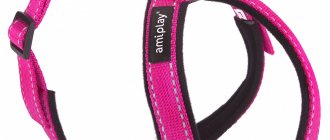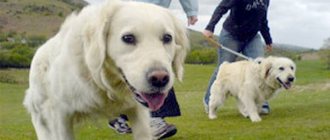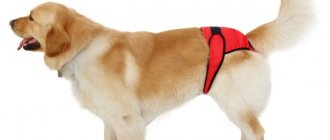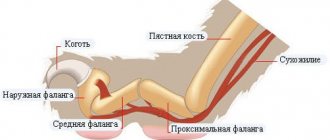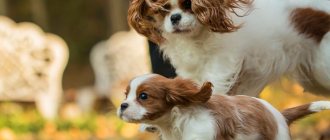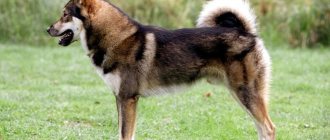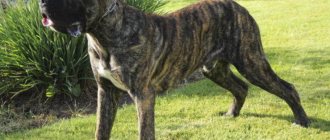What to consider when choosing
Harnesses can be used for various purposes: for regular walks, sports activities or official work. In winter, they can also be used traditionally - to harness a dog to a sled and transport loads with it. Such events can be turned into an interesting game - a pet pushing a child on a sleigh will get the physical exercise he needs and give the family a lot of positive emotions. To know how to choose the right harness for your dog, focus on the following indicators:
- Material. Manufacturers use durable, soft and wear-resistant materials. At the same time, not all companies treat their work responsibly. Please note that during walks a lot of dirt will appear, so the harness should be easy to wash. It is best to make a choice with a minimum amount of knowledge about all the available varieties. For dogs of miniature breeds, light woven products are suitable, while for a wolfhound the best solution would be a heavy leather harness;
- Zas
Collars for dachshunds: types, purpose, tips for choosing. Dog training collar
The correct harness for a dog is in many ways similar to the harness worn on harness horses. This design allows you to use all the draft power of the animal, which makes it an indispensable element of dog sleds. They are made from genuine leather or stitched strips of fabric. It is very important that the owner knows how to choose a harness for dogs; the accessory must be ideal in size, match the breed and physical capabilities of your pet. In this article we will tell you how to choose the right harness for your dog, what types exist and how they can be used.
What are the types?
A walking harness is the most common accessory option, often made of thin material, such as nylon or leather. A riding harness for dogs is one of the very first types of harnesses. This is a more complex system of belts and pieces of fabric, involving the assembly of dogs in one chain for sports competitions or harness racing. The materials for such harnesses are often canvas and nylon. The vast majority of these accessories are intended for large sled dogs such as huskies and malamutes.
A weighted harness is used to train the physical qualities of dogs when it is necessary to better develop them for competitions, and to fix the position of injured dogs and animals after operations. A weighted harness prevents dogs from jumping high and forces them to stay closer to the ground. This is suitable for large and medium breeds, while it can cause injury in small ones.
A harness-vest is a more advanced version of a harness that looks like an element of outerwear. Designed for small and medium-sized short-haired and hairless breeds, helping to insulate dogs in the cold season. Sometimes used as a fixative for medical purposes. The guard harness has increased strength. It consists of 2 or more layers of material, reinforced with stitched belts and metal rings. Used for dogs in protected areas to prevent them from running away.
A puppy harness is a lighter version of a harness designed for walking puppies . The start of using a harness is different for different breeds, but not earlier than six months of age, since a puppy’s muscles and bones are not yet as strong as those of an adult dog.
What to consider when choosing
For dogs, make sure it is easy enough to put on and take off. Several fasteners will increase its resistance to tearing and make it more comfortable for your pet - you can easily adjust its size so that your dog does not feel discomfort;
- Fit to the body. Ideally, the straps are attached tightly to the body so that they do not move when moving. At the same time, the accessory should not restrict the pet’s movements; excessive tension will make walking and running difficult, and can cause inflammation and hair loss in the contact area;
- Matching sizes. Knowing how a harness should sit on a dog will help you make the right choice. First of all, you need to take into account that its upper part must fully correspond to the width of the back (measurement is carried out with a centimeter along the body, taking into account thick fur).
The main requirement for the product is convenience for daily use, but the owner must take into account that it should not be used daily. The harness is considered as a tool for training and special physical training of the pet, but too frequent use can damage the coat. After a walk or completing a required task, it is better to remove it; leaving the dog in a harness at home unattended is unacceptable, as this can lead to undesirable consequences.
Rules for using the “planer”
Parfors for a dog is a method of training it. It may be needed, for example, when a pet does not obey during a walk and pulls on the leash. You cannot use a strict collar for a long time, much less constantly.
To accustom your pet to the “grinder”, at first you should wear it for a short time at home. Training in such equipment should last no more than an hour. If you wear the product for a long time, it may irritate your dog's skin.
During a walk, if the animal tries to rush forward, you should briefly pull it by the “strach”. This will stop the pet and make it obey its owner. This way the dachshund will understand that he has done something inappropriate, and over time he will learn to behave correctly.
But you shouldn’t wear a “strogach” for every walk, so that the animal does not develop an association of pain and irritation associated with the street. In the worst case scenario, the dog may become fearful.
After training, it is worth removing the “stringer” from your pet to protect it from accidental injury. There are cases where dogs left unattended in such collars for long periods of time have seriously injured themselves, resulting in death.
If the dachshund has learned to be obedient, you can part with the “handler.” If everything is done correctly, the pet will obey the owner even in a regular soft collar.
How to measure a dog for a harness
An inexperienced owner does not know how to determine the size of a dog harness. This task can be overwhelming, especially if you go to a large pet store. Sellers can give certain advice, but it is better for the potential buyer to know how to choose the right size harness for a dog. This is especially important for those who make purchases online. To avoid mistakes, you need to take the following measurements using a centimeter:
For representatives of medium and large breeds, a good choice would be equipment made from woven braid or leather. The product must be equipped with steel carabiners and solid rings. This requirement is also true for dogs of small working or hunting breeds - miniature schnauzers, dachshunds, and others. For representatives of decorative breeds, appearance and comfort are more important, so nylon or velor models are the best choice here.
Chain collars for exhibition
If a dog participates in exhibitions, its owner often purchases a metal collar. The chain attracts the attention of viewers and emphasizes the attractive appearance of the dachshund.
To correctly calculate the length of such a collar, you need to add 5 cm to the neck circumference. The steel product is removed before swimming and other water procedures.
When choosing a collar, you should pay attention to its links; they should be made of high-quality alloy. Chemical impurities in metal can irritate the animal's skin and fur. It is desirable that the links be welded, then they will withstand strong jerks. If there are gaps in them, dog hair can get in there, causing injury.
When can you use ammunition with weights?
Pedigree: food for dogs and puppies of small and large breeds
Dogs of fighting breeds begin to be trained using weighted equipment from the age of one year. It is generally accepted that for raising representatives of non-fighting breeds who have not yet reached 1.5 years of age, the use of weights is not permissible. If the dog is predisposed to joint diseases, they are not used at all.
Alternating days of exercise with days of rest, the dog breeder makes notes in a specially kept notebook. Records are kept in pen and are issued in the form of mini-reports on the pet’s health status and changes that have occurred in the dog’s body during training.
Dog equipment with weights
During the first two weeks, the dog is put on a harness with empty pockets. Then the pockets are loaded for a short time with a small amount of weights, the total weight of which is from 50 to 100 g. Weekly, the load is increased by 50–100 g, first of all by weighting the side pockets, and then those located on the back. The maximum weight of loads placed on a young dog should not exceed 4 kg.
Equipment with weights is put on the dog for 30 minutes after warming up, consisting of trotting and jumping. After 5 training days, the dog is given 2 days to rest. During this time, the dog is walked without weights and is not forced to run, jump or overcome obstacles.
Note! Carrying weights around haphazardly can lead to depressing consequences - the animal’s back will bend, the heart will weaken, and the limbs will become twisted.
Decorative
Decorative dogs reach a height of 15 to 25 centimeters, and their maximum weight does not exceed 2-3 kilograms.
Conditions of detention
Decorative dogs were bred specifically for living in an apartment. There is no need to take them for walks every day - they easily learn to go to the toilet in a tray or diaper. In the warm season, they can be taken outside once every 2-3 days, and in winter the number of walks should be reduced as much as possible. Decorative dogs have poor health and should not be cold. Their nutrition also requires special control. Small dogs are very hot-tempered and bark, they remember only basic commands, and are not distinguished by high intelligence.
Advantages and disadvantages
The advantages of keeping decorative dogs include:
Disadvantages include:
Popular representatives
The most popular representatives of this breed:
Decorative dogs are suitable for families with children and busy people who want a pet, but cannot devote a lot of time to it.
Dog Harness Size Chart
Size Belt width in mm Chest coverage from max to min (cm) Dog breeds XL2513090 Central Asian Shepherd, Dogue de Bordeaux, Caucasian Shepherd L2510070 Doberman, German Shepherd, Giant Schnauzer M258060 Labrador, Golden Retriever, Setter X207050 Spaniel, Beagle, Miniature Schnauzer cerXS155540pug, West Highland white terrier, small poodleXXS154533Toy terrier, miniature pinscher , Yorkshire TerrierHow to put a harness on a dog, step by step guide
An owner who has only recently acquired a pet may face categorical rejection. He will resist in every possible way, trying to free himself from the tight harness. This is completely natural, because the dog may not immediately appreciate all its advantages. But if you do the right thing, then over time he will rejoice at the sight of the harness in your hands, because for him it will become a symbol of a walk and a fun time.
How to measure a dog for a harness Knowing how to put a harness on a dog can waste a lot of time; some owners, after several unsuccessful attempts, generally consider it as a useless accessory, depriving them of all the benefits that it can provide. To put it on quickly, use the following guide:
- If your pet is disobedient and refuses to obey, secure it between your legs in the back area.
- Before putting a harness on your dog for the first time, distract him with a favorite treat or toy. If even at this stage you are unable to achieve the required results, then conduct several exercises for endurance;
- Place the ring-shaped part of the closed-type harness around the chest in front of the paws; its dimensions may vary depending on the design of the accessory;
- Next, position the strap along the top of the case to the desired position, thereby limiting the space between the jumper and the closed circle. The right paw is threaded into the area between the closed circle and the strap;
- The jumper passes through the surface of the chest, a strap is put on the right side, after which the loose part must be threaded through the armpit of the left paw. Next, all that remains is to fasten all the belts.
After you manage to tie the dog harness, release it, adjust it and make sure that the accessory does not choke your pet and fits firmly enough to his body. The last step is to check the fastened parts. Even using step-by-step instructions on how to put a harness on a dog, you may encounter certain difficulties. Take your time, perform all the steps sequentially, and do not hesitate to ask questions to familiar dog breeders or store sellers. Harnesses may vary in design, but the principles remain the same.
For large breeds
The harness for oversized large dogs is designed to work with heavy loads. Usually they try to choose a wide leather model that can withstand the significant weight of the animal, multiplied by the speed of its jerk.
Important! Departmental nurseries often use sets with molded buckles - a large animal at the peak of activity can loosen a simple harness or bend a thin ring, from which the belt or leash will immediately fall off. Such a device costs more, but it also has a much greater resource.
For ease of walking, these devices come complete with structures that allow you to hold the leash freely and not tightly. Most often this is a carabiner or a brace connected to a ring located on top of a strip running across the back.
Convenient, especially if the dog is relatively calm and not prone to aggression. But for walks with representatives of fighting or service breeds, such a product is unlikely to be suitable.
For small breeds
Dwarf dachshunds, Spitz dogs and animals of similar size are the “clientele” of mini-harnesses.
In appearance, they are the same as devices for large dogs, only adjusted for size. There are perhaps more materials and colors in this segment than in any other.
Having put such a kit on your mini-dog, you can be sure that he will not go anywhere. In addition to the traditional leash and fastenings, these sets are often equipped with handles firmly sewn to the back strap. That is, an animal that has become excited can simply be picked up and carried away from a dangerous place.
For puppies
The youngest individuals require a special approach. The bone structure of babies is not yet formed, and a regular harness can disrupt the development of paws and muscles (especially in the sternum area).
Did you know? Dogs detect sounds with a frequency of up to 35 kHz, and the human ear works with ranges up to 20.
To avoid such difficulties, puppy kits are used from 6-9 months. The exact figure depends on the breed, so it is worth consulting with your veterinarian.
These sets stand out right away - the strips are narrower, and their leather or nylon base is well lined with soft material (so that the “harness” does not dig into sensitive skin).
For exhibitions
Here it is important to consider not only functionality, but also design.
The decoration and fittings should emphasize the color and noble character of its wearer. This also applies to the color scheme.
Much depends on the owner. The fact is that in pursuit of show endurance, sometimes they resort to trickery, putting a deliberately uncomfortable set on the dog (believing that by taking a size smaller, it will be possible to control its behavior unnoticed by visitors). The result is microtrauma and stress, plus the risk of not qualifying for the next examinations.
Find out what grooming is, how to make a pattern for a dog's overalls, how to choose a clipper and a furminator for your pet.
The other extreme is comfortable, but too bright LED-type harnesses. The flickering lights will only irritate the dog, and he will most likely try to get rid of the source of discomfort.
Freight
Used for training four-legged athletes.
There are two types:
- Half-vests with side pockets in which cargo is placed (rounded stones or bags of sand).
- Standard products with an additional belt, on the edge of which there is a ring with a chain that covers the weighting material. Usually this role is played by a car tire.
The main task is to develop the main muscle groups. In order for the classes to bring only benefits, you will have to control their progress. Jumping and too sudden jerking while wearing a weight harness are contraindicated. Important! During training, make sure that the “weight” in the pockets does not scratch or clog the client’s side. It is better to put sharp or too heavy objects aside.
Vests
Ideal for winter walks for pets with short hair or fine lines.
It is preferable to take products with a fur lining of small thickness - after running around in a vest that is too thick, the dog may catch a cold.
For sledding breeds
A sled harness is only suitable for a hardy and “diversified” dog - a Malamute, Husky or Samoyed.
The design combines strength and comfort for the dog himself. It is sometimes difficult to select such a product, so the way out of the situation is by ordering such kits from craftsmen.
This entails some costs, but such custom tailoring for dogs takes into account all the characteristics of an individual animal. The materials used are durable and moisture-resistant nylon or canvas.
The device itself is also different - there are more belts, as well as fastening rings (which allows you to evenly distribute the load on the body).
Types of harnesses
The modern market for accessories for dog breeders is very diverse and is represented by a large number of products of different types. They can be divided into groups according to size, type of materials used, and purpose. Some models are complemented by special pockets for cargo, fastening rings for harnesses or other elements that expand the functionality of the product. When you go to a pet supply store, you can find the following harnesses:
- Walking. The fastening ring on them is fixed in the withers area. They are well suited for daily walks, which is especially convenient with small pets. Products of larger sizes are equipped with additional belts;
- Towing. Their purpose is sports competitions. Such harnesses are worn on hyperactive dogs prone to non-stop forward movement. With their help, they train the chest muscles for German Shepherds and other breeds. I use it for them
Dog Harness Size Chart
bonds. If your dog requires increased physical activity, use weighted harnesses. Some models are complemented by weights sewn inside, others have pockets with metal bars with which the weight can be adjusted. Their use is advisable for strengthening muscle mass after fractures.
Pay attention to the article types of harnesses.
Progressive dog handlers never wear a harness for every walk and activity. The load should be uniform and appropriate. It is most convenient to train your pet at a very early age, at the same time as a collar, in which case you will need a miniature harness designed specifically for puppies. By putting it on your baby already at this stage, you can accustom him to the idea that a harness and other types of equipment are primarily associated with walks and having fun.
Large
Large dogs grow to a height of 65 centimeters or more and weigh from 25 kilograms. Some representatives of this category reach more than 80-90 centimeters at the withers.
Conditions of detention
Most large dogs are not adapted to living in an apartment. The best conditions for keeping them are the courtyard of a country house or an aviary. They require a lot of space that they will consider their own, and significant attention from the owner. They must be trained, otherwise the animals will become uncontrollable, and a significant amount of time must be devoted to them: playing, training, and even just talking. These are very loyal dogs that become strongly attached to their owner and his family, but at the same time maintain their independence. Large dogs require respect for themselves, therefore, during training and in everyday life, you should not use physical force, shout or show aggression towards them. They are wary of strangers, show very strong protective qualities and strive to protect their family from any threat.
Purpose and design
Such equipment is designed to control the pet’s behavior during a walk and makes it possible to hold it in the most comfortable position.
These products have been around for a long time. True, they were not very well known to a wide circle of dog handlers - for a long time they were used only in sledding. But the convenience of a simple device made it popular and widespread.
This device looks quite simple: fabric or leather belts, running across the chest and along the body (bottom of the body or along the back), are connected in the area of the front legs and spine.
Important! If your dog is nervous due to frequent jerking of the collar, it is better to temporarily switch to a harness (without waiting until his behavior becomes dangerous to others).
This scheme is safe for the dog. If there is a need to hold her, the pressure from the leash is distributed over many points (while the leash simply digs into the neck, causing pain).
Leather products
Leather collars look extremely aesthetically pleasing; they are chosen by owners who attach importance to the appearance of their pet. High-quality leather products have double or triple stitching, thanks to which they do not wear out for a long time.
When choosing a collar, you should look at its inner surface. There should be no threads or knots, these are signs of marriage. Poor-quality firmware can injure the animal’s skin.
The only significant disadvantage of such collars for dachshunds is their high cost. If the product is of high quality, it can cost several thousand rubles.
